Improving the Wear Resistance of Ledeburitic Tool Steels by a Combination of Semi-Solid and Cryogenic Processing
Abstract
:1. Introduction
2. Materials and Methods
2.1. Semi-Solid Processing with Subsequent Thermomechanical Treatment
2.2. Methods of Evaluation
3. Results and Discussion
3.1. Effect of the Number of Deformation Steps on Grain Refinement
3.2. Tempering
3.3. Cryogenic Treatment
3.4. Transmission Electron Microscopy
3.4.1. Structure after Cryogenic Treatment −160 °C/24 h
3.4.2. Structure after Cryogenic Treatment −160 °C/24 h and Tempering 300 °C/2 h
3.5. Wear Tests
3.5.1. Sandblast Test
3.5.2. Pin-on-Disc Test
4. Conclusions
- By inserting 10 deformation steps after the transition to the semi-solid state, a structure with very fine grains of the so-called M-A component with a size of 1 μm and very fine carbides of the M23C and M7C3 type can be obtained. The sharp-edged chromium carbides were also removed from the structure.
- Cryogenic processing leads to the precipitation of additional fine carbides and a reduction in the austenite content of the structure from 41% to 22%, resulting in a significant increase in hardness up to 905 HV10.
- The tempering after cryogenic treatment causes the precipitation of M3C carbide, which had a needle-like morphology compared to the previous carbides.
- The waterjet abrasive sandblast test showed the lowest weight loss after a combination of semi-solid and cryogenic treatment. The samples after this treatment showed up to 40% less weight loss compared to the baseline samples and compared to the Hardox material that is standardly used; the weight loss was 24% less.
- The results were confirmed by the pin-on-disk method. The lowest wear rate was achieved for the samples after combined semi-solid and cryogenic treatment.
Author Contributions
Funding
Data Availability Statement
Acknowledgments
Conflicts of Interest
References
- Filippov, M.A.; Gervas’Ev, M.A.; Plotnikov, G.N.; Zhilin, A.S.; Nikiforova, S.M. Formation of Structure of Wear-Resistant Steels 150KhNML and Kh12MFL upon Quenching. Met. Sci. Heat Treat. 2016, 57, 641–644. [Google Scholar] [CrossRef]
- Filippov, M.A.; Sharapova, V.A.; Shveykin, V.P.; Nikiforova, S.M. Heat Treatment Effect on Ledeburite Alloys Wear Resistance. Mater. Today Proc. 2021, 38, 1810–1812. [Google Scholar] [CrossRef]
- Shah, K.P. Construction, Working and Maintenance of Crushers for Crushing Bulk Materials; Hindawi: London, UK, 2018; pp. 1–53. [Google Scholar]
- Hietala, M.; Ali, M.; Khosravifard, A.; Keskitalo, M.; Jarvenpaa, A.; Hamada, A. Optimization of the Tensile-Shear Strength of Laserwelded Lap Joints of Ultra-High Strength Abrasion Resistance Steel. J. Mater. Res. Technol. 2021, 11, 1434–1442. [Google Scholar] [CrossRef]
- Rojacz, H.; Katsich, C.; Kirchgaßner, M.; Kirchmayer, R.; Badisch, E. Impact-Abrasive Wear of Martensitic Steels and Complex Iron-Based Hardfacing Alloys. Wear 2022, 492–493, 204183. [Google Scholar] [CrossRef]
- Haiko, O.; Javaheri, V.; Valtonen, K.; Kaijalainen, A.; Hannula, J.; Kömi, J. Effect of Prior Austenite Grain Size on the Abrasive Wear Resistance of Ultra-High Strength Martensitic Steels. Wear 2020, 454–455, 13–16. [Google Scholar] [CrossRef]
- Jirková, H.; Rubešová, K.; Konopík, P.; Opatová, K. Effect of the Parameters of Semi-Solid Processing on the Elimination of Sharp-Edged Primary Chromium Carbides from Tool Steel. Metals 2018, 8, 713. [Google Scholar] [CrossRef] [Green Version]
- Rubešová, K.; Peković, M.; Jirková, H.; Hradil, D. Resistance of Tool Steel Processed by Unconventional Forming Technology against Abrasive Wear. Manuf. Technol. 2021, 21, 240–245. [Google Scholar] [CrossRef]
- Rubešová, K.; Pekovic, M.; Jirková, H. Innovative Process to Eliminate Ledeburite Network in Tool Steel. Manuf. Technol. 2017, 17, 940–945. [Google Scholar] [CrossRef]
- Jirková, H.; Aišman, D.; Mašek, B. Unconventional Structure of X210Cr12 Steel Obtained by Thixoforming. J. Alloys Compd. 2010, 504, 500–503. [Google Scholar] [CrossRef]
- Jirková, H.; Rubešová, K.; Opatová, K.; Peković, M.; Mašek, B. Effect of Heating Temperature during Semi-Solid Processing on Structure of X210CR12 Steel. Acta Metall. Slovaca 2017, 23, 229–235. [Google Scholar] [CrossRef]
- Song, R.; Kang, Y.; Zhao, A. Semi-Solid Rolling Process of Steel Strips. J. Mater. Process. Technol. 2008, 198, 291–299. [Google Scholar] [CrossRef]
- Bombac, D.; Fazarinc, M.; Podder, A.S.; Kugler, G. Study of Carbide Evolution during Thermo-Mechanical Processing of AISI D2 Tool Steel. J. Mater. Eng. Perform. 2013, 22, 742–747. [Google Scholar] [CrossRef]
- Püttgen, W.; Hallstedt, B.; Bleck, W.; Uggowitzer, P.J. On the Microstructure Formation in Chromium Steels Rapidly Cooled from the Semi-Solid State. Acta Mater. 2007, 55, 1033–1042. [Google Scholar] [CrossRef]
- Balan, T.; Becker, E.; Langlois, L.; Bigot, R. A New Route for Semi-Solid Steel Forging. CIRP Ann.-Manuf. Technol. 2017, 66, 297–300. [Google Scholar] [CrossRef]
- Kopp, R.; Kallweit, J.; Möller, T.; Seidl, I. Forming and Joining of Commercial Steel Grades in the Semi-Solid State. J. Mater. Process. Technol. 2002, 130, 562–568. [Google Scholar] [CrossRef]
- Uhlenhaut, D.I.; Kradolfer, J.; Püttgen, W.; Löffler, J.F.; Uggowitzer, P.J. Structure and Properties of a Hypoeutectic Chromium Steel Processed in the Semi-Solid State. Acta Mater. 2006, 54, 2727–2734. [Google Scholar] [CrossRef]
- Aisman, D.; Jirkova, H.; Kucerova, L.; Masek, B. Metastable Structure of Austenite Base Obtained by Rapid Solidification in a Semi-Solid State. J. Alloys Compd. 2011, 509, S312–S315. [Google Scholar] [CrossRef]
- Aišman, D.; Jirková, H.; Mašek, B. The Influence of Deformation and Cooling Parameters after Transition through Semi-Solid State on Structure Development of Ledeburite Steel. J. Alloys Compd. 2012, 536, S204–S207. [Google Scholar] [CrossRef]
- Das, D.; Dutta, A.K.; Toppo, V.; Ray, K.K. Effect of Deep Cryogenic Treatment on the Carbide Precipitation and Tribological Behavior of D2 Steel. Mater. Manuf. Process. 2007, 22, 474–480. [Google Scholar] [CrossRef]
- Jandová, D.; Šuchmann, P.; Nižňanská, J. Microstructure of Tool Steel X37CrMoV5 after Cryogenic Treatment and Its Effect on Wear Resistance. Key Eng. Mater. 2015, 647, 23–37. [Google Scholar] [CrossRef]
- Collins, D.N.; Dormer, J. Deep Cryogenic Treatment of a D2 Cold-Work Tool Steel. Heat Treat. Met. 1997, 24, 71–74. [Google Scholar] [CrossRef]
- Stratton, P.F. Optimising Nano-Carbide Precipitation in Tool Steels. Mater. Sci. Eng. A 2007, 449–451, 809–812. [Google Scholar] [CrossRef]
- JMatPro, Release 12.0; Sente Software Ltd.: Guildford, UK, 2022.
- ČSN 41 9436; Ocel 19436 Chromová. Český Normalizační Institut: Praha, Czech Republic, 1994.
- SIJ Group: Data Sheet for X210Cr12. Available online: https://steelselector.sij.si/steels/OCR12.html (accessed on 21 October 2022).
- Dörrenberg Edelstahl: Data Sheet for X210Cr12. Available online: https://www.finemetal.ro/wp-content/uploads/2020/09/1.2080-CP10V-X210Cr12.pdf (accessed on 21 October 2022).
- Jovičević-Klug, P.; Jovičević-Klug, M.; Sever, T.; Feizpour, D.; Podgornik, B. Impact of steel type, composition and heat treatment parameters on effectiveness of deep cryogenic treatment. J. Mater. Res. Technol. 2021, 14, 1007–1020. [Google Scholar] [CrossRef]
- Podgornik, B.; Paulin, I.; Zajec, B.; Jacobson, S.; Leskovšek, V. Deep Cryogenic Treatment of Tool Steels. J. Mater. Process. Technol. 2016, 229, 398–406. [Google Scholar] [CrossRef]
- Liu, H.; Wang, J.; Shen, B.; Yang, H.; Gao, S.; Huang, S. Effects of deep cryogenic treatment on property of 3Cr13Mo1V1.5 high chromium cast iron. Mater. Des. 2007, 3, 1059–1064. [Google Scholar] [CrossRef]
- Beköz Üllen, N. Investigation of the Wear Resistance of Hardox Steel Plates. In Proceedings of the 2nd International Conference on Tribology-TURKEYTRIB’18, Istanbul, Turkey, 18–20 April 2018; pp. 69–73. [Google Scholar]
- Filip, A.C.; Vasiloni, M.A.; Mihail, L.A. Experimental Research on the Machinability of Hardox Steel by Abrasive Waterjet Cutting. MATEC Web. Conf. 2017, 94, 03003. [Google Scholar] [CrossRef] [Green Version]
- Mazur, M.; Mikova, K. Impact Resistance of High Strength Steels. Mater. Today Proc. 2016, 3, 1060–1063. [Google Scholar] [CrossRef]
- SSAB: Data Sheet for Hardox 450. Available online: https://www.ssab.com/en/products/brands/hardox/products/hardox-450 (accessed on 21 October 2022).
- SSAB: Data Sheet for Hardox 600. Available online: https://www.ssab.com/en/products/brands/hardox/products/hardox-600 (accessed on 21 October 2022).
- Hradil, D.; Duchek, M.; Jirková, H.; Rubešová, K. Impact of Semi-Solid Processing and Cryogenic Treatment on Wear Resistance of X210Cr12 Tool Steel. IOP Conf. Ser. Mater. Sci. Eng. 2021, 1178, 012021. [Google Scholar] [CrossRef]
- Amini, K.; Nategh, S.; Shafyei, A. Influence of Different Cryotreatments on Tribological Behavior of 80CrMo12 5 Cold Work Tool Steel. Mater. Des. 2010, 31, 4666–4675. [Google Scholar] [CrossRef]
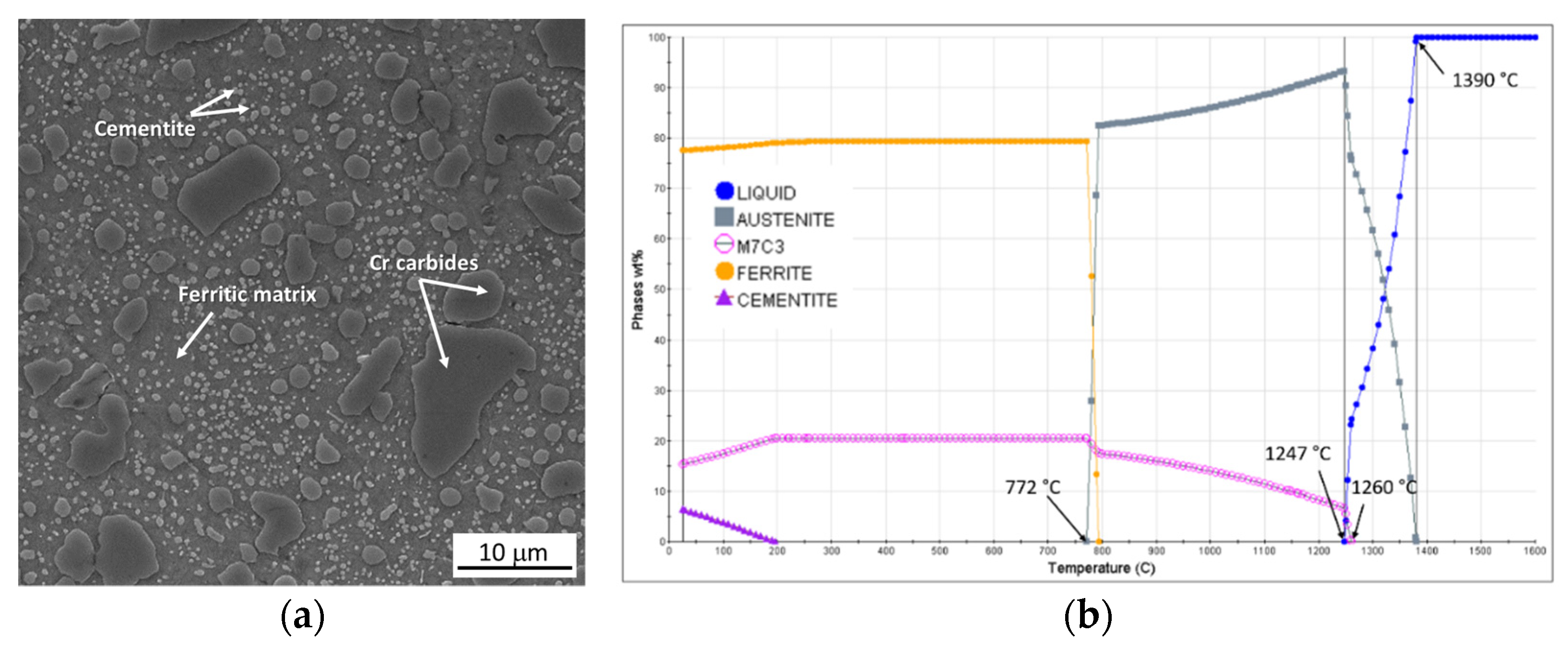
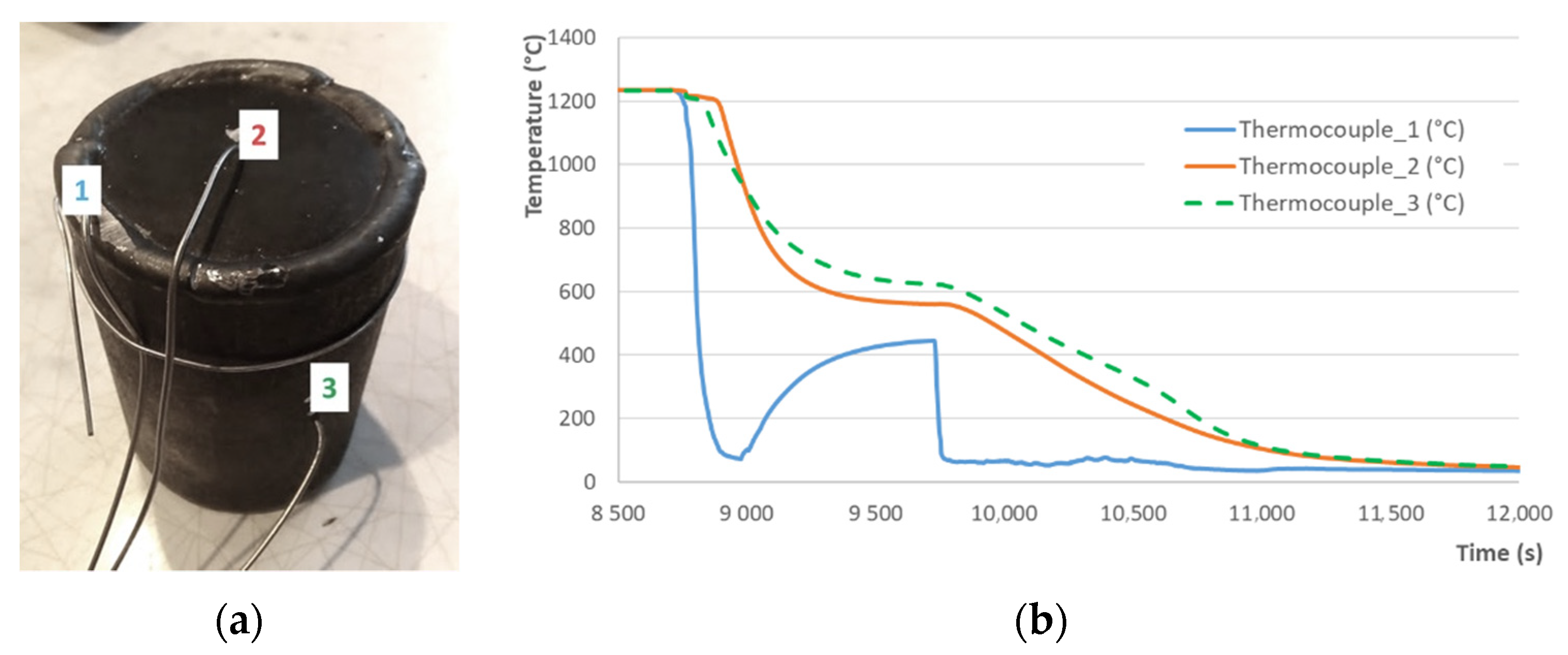


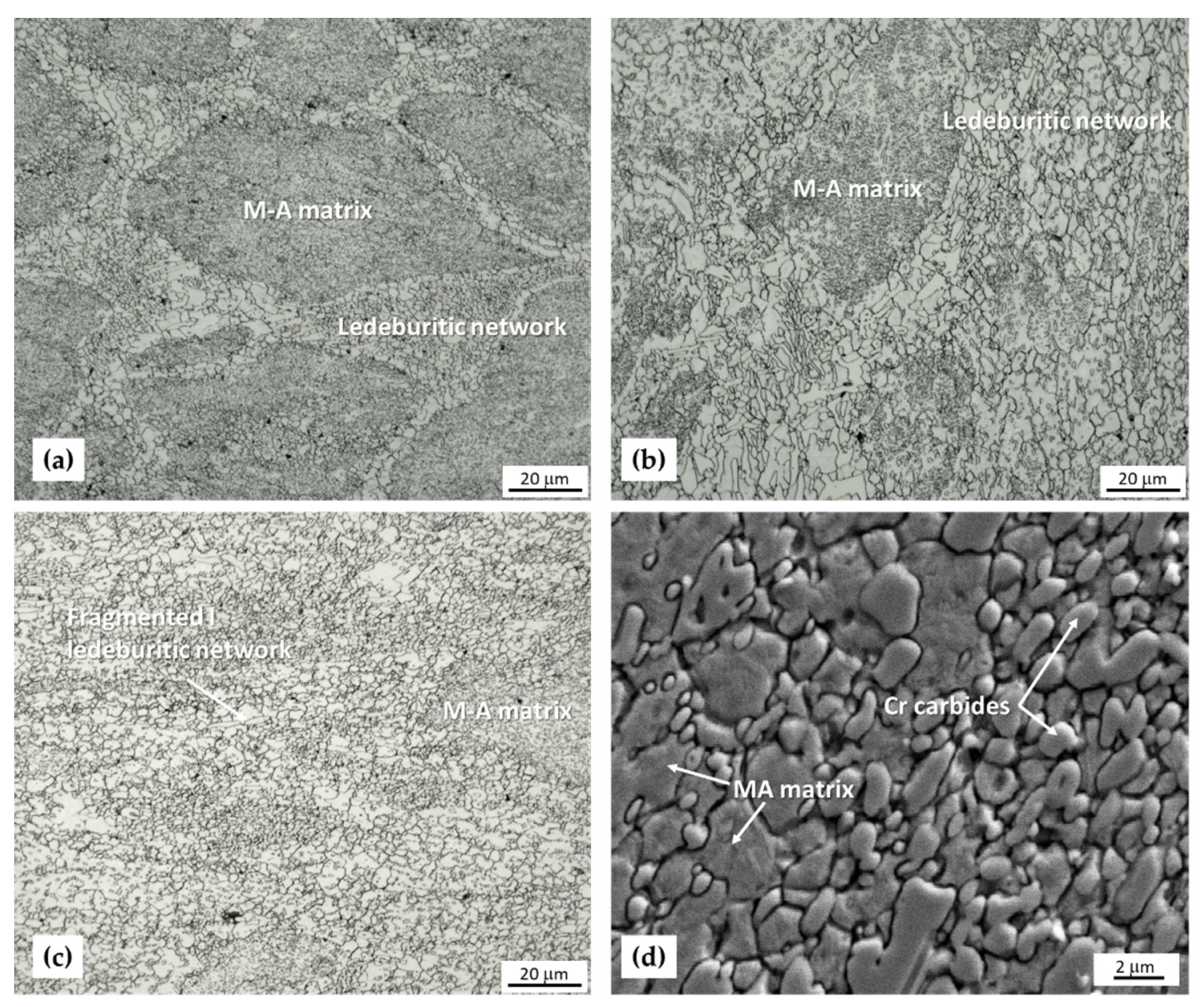

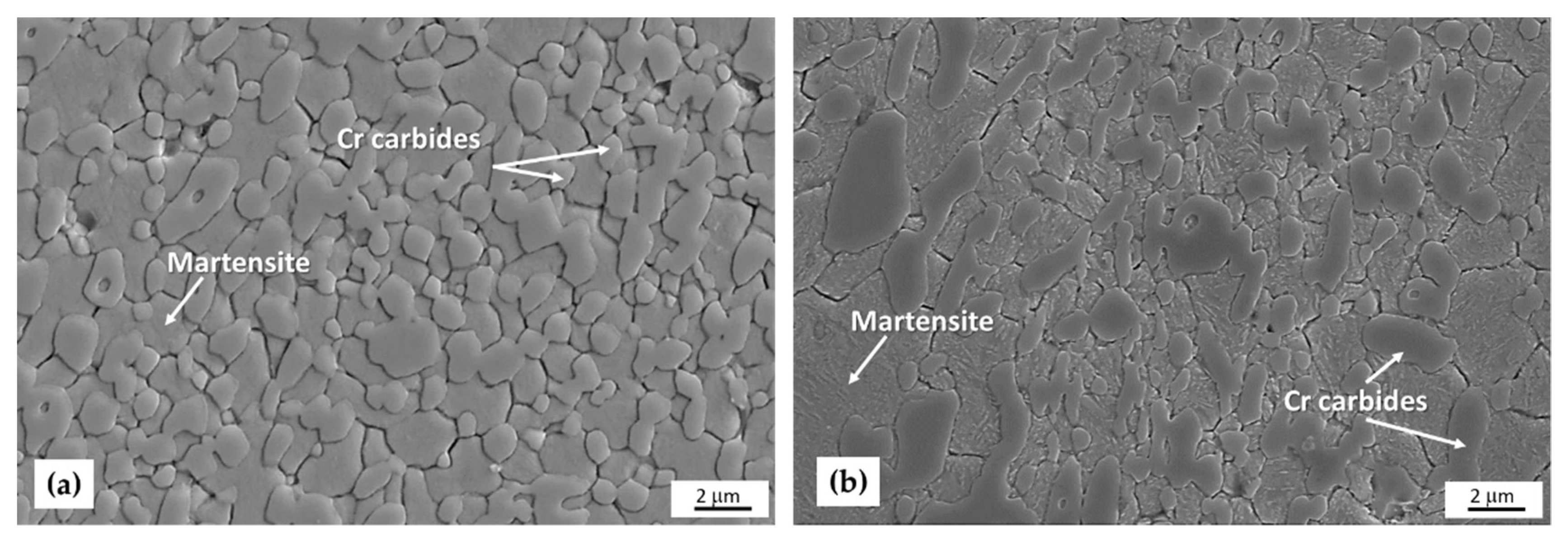

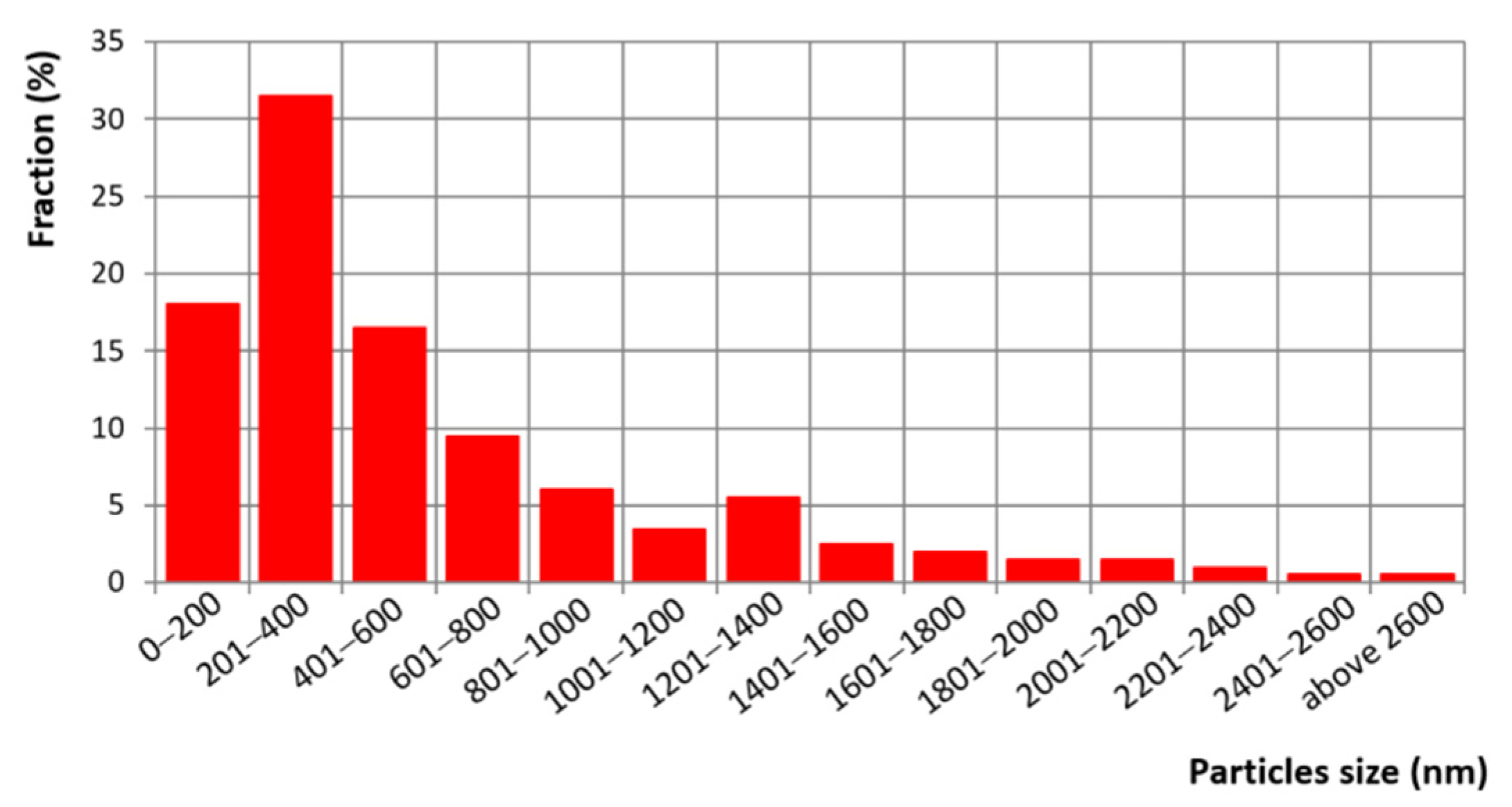








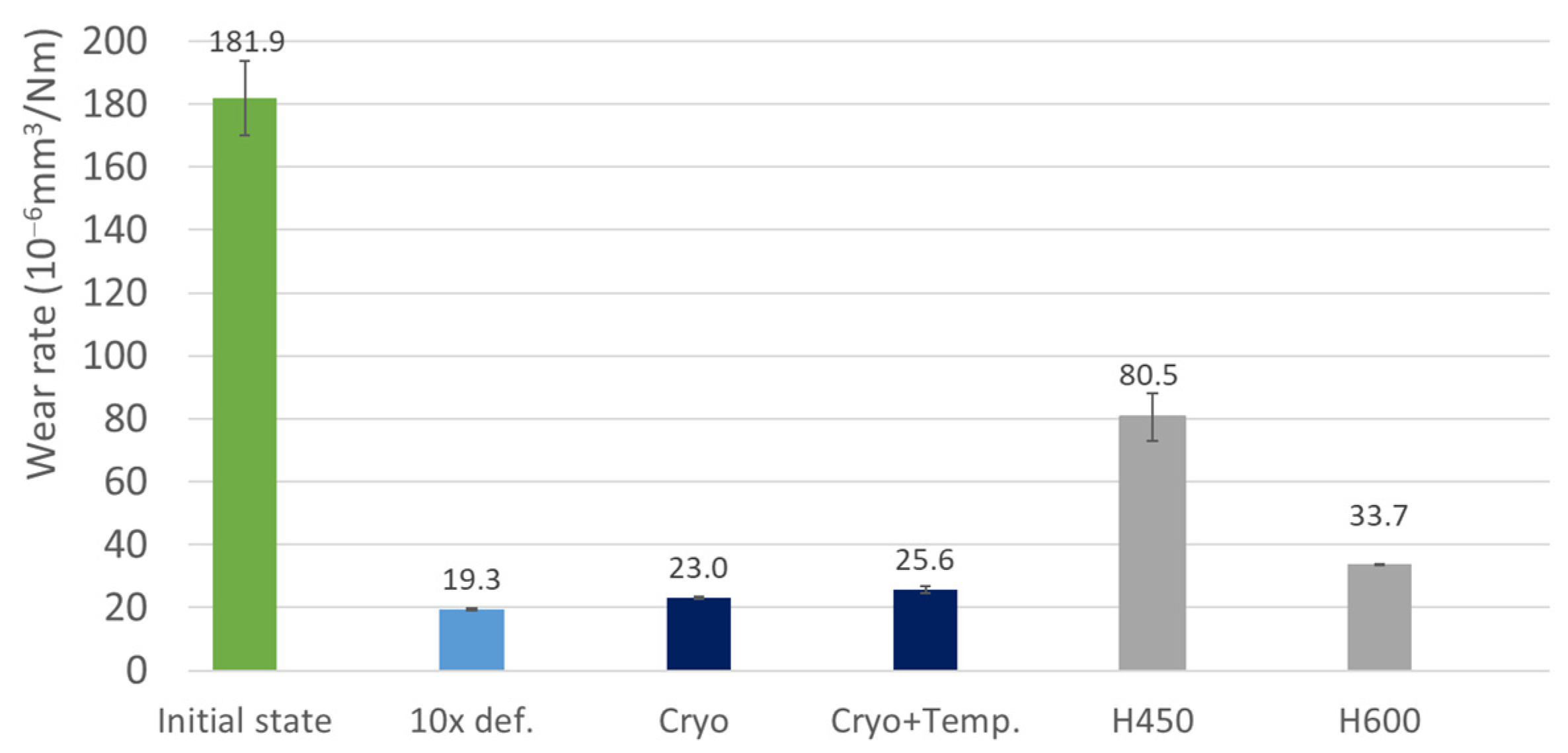
| C | Si | Mn | Cr | P | S |
|---|---|---|---|---|---|
| 1.9–2.2 | 0.1–0.6 | 0.2–0.6 | 11–13 | max. 0.03 | max 0.01 |
| Regime | Heating Temperature [°C]/Time [min.] | Reheating Temperature [°C]/Time [min.] | Number of Forming Steps | Tempering Temperature [°C]/Time [h] | Cryogenic Treatment Temperature [°C]/Time [h] | Tempering Temperature [°C]/Time [h] |
|---|---|---|---|---|---|---|
| 3 × def. | 1250/60 | 1080/30 | 3 | - | - | - |
| 5 × def. | 5 | - | - | - | ||
| 10 × def. | 10 | - | - | - | ||
| Temp. | 10 | 300/2 | - | - | ||
| Cryo | 10 | - | −160/24 | - | ||
| Cryo + Temp. | 10 | - | −160/24 | 300/2 |
| D (10−9 m) | NA (1012 m−2) | NV (1019 m−3) | L (10−7 m) |
|---|---|---|---|
| 623 * | 2.836 ± 0.645 | 5.722 ± 0.484 | 2.515 ± 0.558 |
| D (10−9 m) | NA (1013 m−2) | NV (1020 m−3) | L (10−7 m) |
|---|---|---|---|
| 400 * | 2.651 ± 0.725 | 5.302 ± 0.532 | 0.687 ± 0.152 |
| Steel | C | Si | Mn | Cr | Ni | Mo | B | P | S |
|---|---|---|---|---|---|---|---|---|---|
| Hardox 450 | 0.18 | 0.25 | 1.3 | 0.1 | 0.1 | 0.04 | 0.003 | 0.015 | 0.001 |
| Hardox 600 | 0.4 | 0.56 | 1.0 | 1.2 | 1.5 | 0.60 | - | 0.015 | 0.010 |
| Sample | Grain Size (μm) | Hardness HV10 (-) | Weight Loss (g) |
|---|---|---|---|
| Initial state | - | 216 ± 3 | 1.73 ± 0.22 |
| Conventional heat treated | - | 716 ± 9 | 1.75 ± 0.05 |
| 5 × def. | 4.6 ± 2.1 | 633 ± 3 | 1.54 ± 0.05 |
| 10 × def. | 1.4 ± 0.5 | 738 ± 19 | 1.40 ± 0.04 |
| Cryo | 1.4 ± 0.6 | 905 ± 5 | 1.33 ± 0.03 |
| Cryo + Temp. | 1.4 ± 0.4 | 844 ± 14 | 1.61 ± 0.03 |
| Hardox 450 | - | 465 ± 8 | 1.55 ± 0.02 |
| Hardox 600 | - | 660 ± 9 | 1.65 ± 0.03 |
Publisher’s Note: MDPI stays neutral with regard to jurisdictional claims in published maps and institutional affiliations. |
© 2022 by the authors. Licensee MDPI, Basel, Switzerland. This article is an open access article distributed under the terms and conditions of the Creative Commons Attribution (CC BY) license (https://creativecommons.org/licenses/by/4.0/).
Share and Cite
Jirková, H.; Rubešová, K.; Jeníček, Š.; Hradil, D.; Kučerová, L. Improving the Wear Resistance of Ledeburitic Tool Steels by a Combination of Semi-Solid and Cryogenic Processing. Metals 2022, 12, 1869. https://doi.org/10.3390/met12111869
Jirková H, Rubešová K, Jeníček Š, Hradil D, Kučerová L. Improving the Wear Resistance of Ledeburitic Tool Steels by a Combination of Semi-Solid and Cryogenic Processing. Metals. 2022; 12(11):1869. https://doi.org/10.3390/met12111869
Chicago/Turabian StyleJirková, Hana, Kateřina Rubešová, Štěpán Jeníček, David Hradil, and Ludmila Kučerová. 2022. "Improving the Wear Resistance of Ledeburitic Tool Steels by a Combination of Semi-Solid and Cryogenic Processing" Metals 12, no. 11: 1869. https://doi.org/10.3390/met12111869






